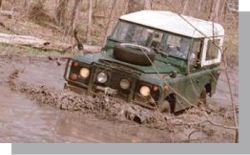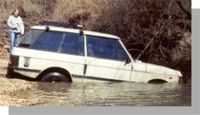|
OKoffroad.com — 4x4 Editorial |
|
. |
|
Dive, Dive Dive! - Dealing with Water |
| . |
 |
by Jim Allen
reprinted with permission |
Water is not a natural environment for 4x4s, like many
of the hostile environments encountered by 4x4s, it likes to bite unwary four-wheelers in the
butt.

reprinted with permission
Look Before You Leap
You wouldn't dive headfirst into unknown murky water, so why would you drive into it? Unless you
just watched a vehicle of similar capability cross [an established ford], don't take it for
granted that you can.
In general, moving water is the safest, because deep silt is not usually present, though you may
find soft sand. Many streams have a rocky bottom, which is good in the sense that you won't sink,
but bad in offering more danger of cut tires or large, diff-denting rocks.
Once you have determined it's safe to cross, a few preparations might be in order, depending on
the water depth. If you are going deep, a plastic bag can be put over the grill to prevent
massive amounts of water pushing through the radiator into the fan.

How Deep Can You Go?
This should be really three questions: How deep can you go, should you go, or are you supposed to
go? The can part is limited to the point where the engine will stop and leave you stranded. The
should is the point where you'll end up with so much cleanup, maintenance work or repairs
afterwards that you'll wonder whether it was all worth it. As to how deep you are supposed to go,
that variable depends on your rig and manufacturer recommendations.
In general terms, your fording limits are dictated by the lowest vulnerable component. That could
be an axle vent, a low mounted fuel injection ECU or the air intake.
|
. |
Dive, Dive, Dive!
Use low range and a low gear. Enter the water slowly as the vehicle is most vulnerable to
scooping water into the engine compartment and creating problems at this point. Once fully in the
water, proceed at a steady pace, making a modest "bow wave." The right bow wave helps keep water
out of the engine compartment by forming a depression under the engine.
A soft bottom might require more momentum to avoid getting stuck. A rocky bottom needs a slower
speed to avoid tire or undercarriage damage. Be ready to react quickly to changing conditions.
In mud or silt, some extra throttle might be needed quickly. If you fall into a small hole, and
hopefully it's a small one, momentum may carry you through. If it's a big one, you may have time
to stop and back out. If it looks like you're falling deep enough for your engine to ingest water
via the intake, shutting the engine off quickly may prevent serious damage.

After Fording Checks
When you get under way, make a few stops to test and dry the brakes. Drum brakes dry much more
slowly and unevenly than discs. In deep water, it's possible that the axles, axle universals or
CV joints or driveshaft U-joints have inhaled dome water. Remember, oil seals are designed to
keep what's inside, inside, not what's outside from getting in.
Unless there is evidence or suspicion of serious water contamination, you can wait till you are
home for a serious underside inspection. At that time, I always recommend a couple of squirts of
grease into all the lube fittings (suspension and driveline) to drive water out and to check the
diff oils for water contamination. Serious water contamination will result in gear oil that turns
white and this goo must be flushed ASAP. Units with closed knuckle front axles (most early rigs
and some later rigs like Land Rovers and Toyotas) will need further inspection to ensure that
water has not entered these housings.
If the vehicle has been in deep water, there are a multitude of other potential problems. The
general rule of thumb for modern vehicles is if water was high enough to reach into the dashboard
in a significant way, you have a very hurting unit and a possible total. |
. |
|
|
. |
| . |
Fourwheeling for me:
"Twenty-five years ago, it struck me that I'd rather be at 2mph on a rocky
trail, with half a tire hanging over a 2,000 foot drop, than in a sports car
on asphalt, cornering at 80 mph at the edge of tire adhesion."
Jim Allen
Author of "Jeep," "Chevy and GMC Pickup Performance Handbook,"
"Illustrated Jeep Buyers Guide," "Jeep 4x4 Performance Handbook," "Classic
4x4s Buyers Guide," and about a thousand magazine articles on four-wheel
drive topics since 1982.
(Thank you from OKoffroad.com)
|
.
|
|
. |
|
|